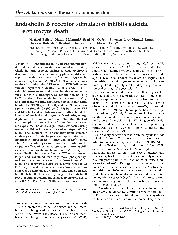摘要
Endothelins (ETs), potent endothelium-derived mediators, stimulate formation of nitric oxide, which, in turn, protects against suicidal erythrocyte death or eryptosis, characterized by phosphatidylserine exposure at the erythrocyte surface and triggered by increase in cytosolic Ca(2+) ([Ca(2+)](i)). The present study explored whether the ET1-receptor ETB influences suicidal erythrocyte death. To this end, [Ca(2+)](i) (Fluo3-fluorescence) and phosphatidylserine exposure (annexin V-binding) were determined utilizing FACS analysis. Energy depletion increased [Ca(2+)]i and phosphatidylserine-exposure, effects significantly blunted by ET1 (IC(50) approximate to 100 nM) and the ETB receptor-agonist sarafotoxin 6c (IC(50) approximate to 10 nM) but not by ET2 and ET3. ET1 and sarafotoxin significantly delayed the kinetics of suicidal erythrocyte death following energy depletion. ETB stimulation did not blunt the effect of Ca(2+)-ionophore ionomycin (1 mu M) on phosphatidylserine exposure. The in vivo significance was tested using rescued ETB-knockout (etb(-/-)) and wild-type (etb(+/+)) mice. The number of phosphatidylserine-exposing erythrocytes, of reticulocytes and spleen size were significantly larger in etb(-/-) mice than in etb(+/+)-mice. The etb(-/-) erythrocytes were more susceptible to the eryptotic effect of oxidative stress and more rapidly cleared from circulating blood than etb(+/+) erythrocytes. Finally, the spleens from etb(-/-) mice were enlarged and contained markedly more phosphatidylserine- exposing erythrocytes than spleens from etb(+/+) mice. The observations disclose a novel function of ET1, i. e., protection from suicidal erythrocyte death.-Foller, M., Mahmud, H., Qadri, S. M., Gu, S., Braun, M., Bobbala, D., Hocher, B., Lang, F. Endothelin B receptor stimulation inhibits suicidal erythrocyte death. FASEB J. 24, 3351-3359 (2010). www.fasebj.org
- 出版日期2010-9
